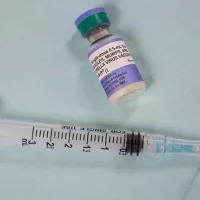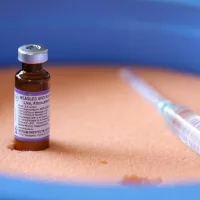(AUSTIN, TX) — Health and Human Services Secretary Robert F. Kennedy Jr. seemed to imply in recent days that the measles outbreak in western Texas was slowing down.
In a post on X on Sunday, Kennedy remarked on the second death linked to the outbreak, which occurred in an unvaccinated school-aged child.
About 10 minutes later, Kennedy edited the post to add that the curve has been flattening since early March, when he started sending in reinforcements from the Centers for Disease Control and Prevention — supplying clinics with vaccines and other medications.
“Since that time, the growth rates for new cases and hospitalizations have flattened,” he wrote.
However, data from the Texas Department of State Health Services showed that cases are increasing, with more counties in western Texas reporting infections.
Katherine Wells, director of public health for Lubbock, Texas, said last week that public health officials were projecting “a year-long timeline for control of the outbreak.”
“This is going to be a large outbreak, and we are still on the side of increasing number of cases, both due to spread and increased testing capacity,” she said.
Public health specialists told ABC News they are skeptical that the curve is flattening and believe that cases linked to the outbreak are not only increasing, but likely much higher than the official case count.
“This outbreak is far from under control — even if the curve begins to flatten, we still face major risks in under-vaccinated communities across the country,” said Dr. John Brownstein, an epidemiologist and chief innovation officer, as well as an ABC News contributor. “With so many pockets of low vaccination, we’re still on the brink of widespread, sustained transmission unless urgent action is taken.”
Likely more cases in Texas
As of Tuesday, there have been 505 confirmed measles cases in Texas, according to DSHS data.
Between March 28 and April 4, DSHS confirmed 81 cases — one of the highest totals confirmed in a single week since the first cases were identified in late January. The Texas Department of State Health Services does not make hospitalization rates available to the public.
“We know that there have been more cases, at least sustained cases, over the past couple months. We know that the size of the outbreak has jumped pretty substantially over the past month,” Dr. Craig Spencer, an associate professor of the practice of health services, policy and practice at the Brown University School of Public Health, told ABC News.
ABC News has requested a copy of the data that Kennedy is referring to when making claims about the curve flattening, but has not yet heard back from the HHS.
“We don’t have a full picture of what’s happening on the ground because of our inability to reach some communities. And so, I certainly would not feel confident saying that we have plateaued,” he added.
Spencer said one reason he is not comfortable saying the outbreak has plateaued in Texas is that he believes the number of cases is likely an undercount.
Texas DSHS said any cases reported after March 16 are incomplete, and additional cases may be reported.
There have been two confirmed deaths linked to the Texas outbreak and a third death is being investigated in New Mexico in an unvaccinated adult who tested positive after dying.
“We know that there’s really, on average, about one death for every around 1,000 cases,” Spencer said. “We’ve already seen three deaths, which would make you suspect it’s probably more like 3,000 cases.”
“It feels very, very likely that the count is higher than 500,” he said, adding, “It’s not impossible for there to be three deaths among 500 cases, but statistically, one would expect more cases for that number of deaths.”
Dr. Megan Ranney, dean of the Yale School of Public Health, told ABC News there is risk in saying the cases have flattened when the data may suggest otherwise. Namely, she said is worried that people may be dissuaded from getting tested or treated.
“We know that many people are avoiding formal medical care and therefore testing. There is always a delay in reporting even when people are tested,” Ranney said. “I worry that people are afraid to get measles tested or to bring their kid in for care.”
“My other worry is we still want people to take prevention measures and, of course, we know the vaccine is not only the safest way, but also the most effective way to prevent infection with measles,” she continued.
Kennedy promotes catch-all treatments not intended for all measles cases
In a second social media post on Sunday evening, Kennedy shared that he had met the families of the two school-aged children who died of measles in Texas, as well as a third family who reportedly had a daughter in the ICU for three weeks with measles.
Kennedy said he also met with two physicians who have “treated and healed” about 300 children infected with measles in the Mennonite community with aerosolized budesonide and clarithromycin.
Aerosolized budesonide is a steroid used to reduce inflammation in the lungs, making it easier to breathe. Clarithromycin is an antibiotic used to treat bacterial infections.
“If you were to go to any evidence-based treatment guidelines, there is nothing that says you should treat patients with budesonide or clarithromycin,” Spencer said. “Now those are medications that have a broad suite of uses, and so I’m not going to say that they have absolutely no indication for measles, or really anything else.”
He said there are scenarios in which either medication may be used in a measles patient, but it is on a case-by-case basis.
“I don’t think that they’re hurting anyone, but they’re probably not helping anyone,” he added. “They are not at all tools that I would reach to as my first, or really even second, line of tools that I would use in someone presenting with symptoms consistent with measles.”
In an interview with ABC News Live on Monday, Dr. Peter Marks, the former director of the Center for Biologics Evaluation and Research within the Food and Drug Administration — who is reported to have been forced out — said budesonide, clarithromycin and vitamin A — another treatment endorsed by Kennedy — are neither preventatives nor “real treatment” for all cases of measles.
He highlighted the importance of receiving the measles, mumps and rubella, or MMR, vaccine. The CDC currently recommends that people receive two doses of the MMR vaccine, the first at ages 12 to 15 months and the second between 4 and 6 years old. One dose is 93% effective, and two doses are 97% effective against measles or nearly 100% effective against dying of measles after contracting it.
Some people may be at risk for an adverse reaction with any vaccine, so experts say it’s important to discuss the risks and benefits with a health care provider.
“It should be an easy decision, as easy as buying a car seat and strapping your kid in,” Marks said about getting a vaccine if eligible. “You would never drive without your kid strapped into their car seat. You know, if you had an 18-month-old, why wouldn’t you give that child something that could prevent your child from dying of an infection when there’s a one in 1,000 chance if they get measles, they would die from it?”
ABC News’ Dr. Mark Abdelmalek contributed to this report.
Copyright © 2025, ABC Audio. All rights reserved.














